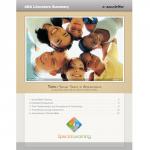As a continuation from last week’s Strategies to Prevent Challenging Behavior in the Classroom, here are 4 additional behavior management strategies: (1) Providing choices, (2) Structuring the environment, (3) Assessing how instruction is being provided, and (4) Assessing the student’s ability.
Everyone wants the ability to make choices – we all want to feel that we are a part of the decisions being made for us – this all helps us feel like we are in control. As the teacher is the leader of the classroom, providing choices in the classroom help students to feel empowered and motivated.
As much as possible, allow your students to make choices in the delivery of instructional tasks. So for example, if your student prefers to work on math prior to reading, allow him to make this choice. If our student wants to use his new Thomas the Train pencil that his mother just provided, allow him to make this choice. If your student wants to work in a quieter area to complete his reading assignment as opposed to sitting in a group environment with loud peers; again, allow him to make this choice.
When students are engaging in challenging behavior because they do not want to complete the activities provided, allowing choice can be an effective teaching tool to prevent these behaviors.
Structure the Environment
Sometimes students need an environmental change to keep them focused and engaged which in turn will promote appropriate classroom behavior. Make your classroom structured and predicable.
Use visual schedules so your student knows what he is expected to do and when. You can create manipulative schedules, allowing the student to match to the different locations within the classroom and across the different school environments (i.e., cafeteria, gym, music room, etc.). This helps to make transitions more concrete for the students.
Provide a location designated for the group instruction versus one on one instruction. Create stations with designated activities so the student knows what to expect in these different locations.
If you have a student who attempts to elope (leave the classroom without approval), move his desk away from the classroom’s door.
If you have students who are easily distracted, removing these distracting materials will make him more successful when teaching occurs. If you have a student who tends to grab materials and destroy them, keep them out of his reach unless you are directly teaching him. Plastic bins and shelves are great resources for children with special needs.
If you have a student who engages in aggression toward other students, keep his instructional area away from others and make sure an aide is with him to monitor appropriate social behavior.
Assessing how instruction is being provided
Discrete Trial Teaching (DTT) is the most effective teaching methodology for many students diagnosed with autism spectrum disorders (ASD). This does not mean the ALL students diagnosed with ASD will require DTT, but many do require direct instruction with a systematic increase of discrimination. If a student is unable to acquire new skills through typical teaching instruction, DTT should be considered. The use of discrete trials is not limited to the DTT methodology; a teacher can also utilize Natural Environment Teaching, Incidental Teaching, Precision Teaching, and Direction Instruction.
In addition, Errorless Teaching is the most supportive technique in teaching a student with autism. This entails showing the student how to perform and systematically fading the use of prompts. This ensures the student’s success with responding prior to providing him corrective feedback. Could you imagine how it would feel to hear that you are doing something wrong without anyone providing you guidance first? We want to prevent this feeling.
If a student is not receiving appropriate instruction that promotes skill acquisition, challenging behavior will persist.
Assess your student’s ability
It is important to assess your student’s learning ability. This is not limited to a one-time assessment provided at the beginning of the year, but continuous functional behavior assessment that occurs throughout the school year.
Questions to ask yourself:
1. Is the curriculum functionally-designed? Will the skills that I am teaching him provide him independence, not just with academic skills, but with communication and socialization skills as well? If we are not teaching functional, appropriate behavior, challenging behavior will persist.
2. Is the ABA curriculum too challenging for the student? Is the curriculum too easy for the student? This is a delicate balance – if teaching goals have been adequately assessed, boredom and resistance to instruction can be avoided.
3. What is the rate of instruction? Am I going too fast for the student or am I going too slow? This is going to be specific to each student in your classroom and will need continual assessment.
Check back for more Strategies on Preventing Challenging Behavior in the Classroom!







